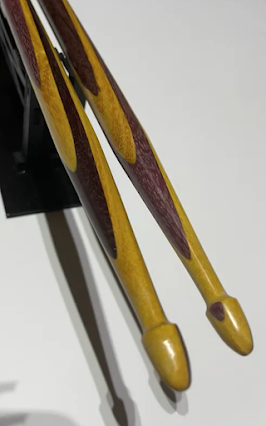Techra is an Italian company that focuses exclusively on carbon sticks and accessories. I'd been intrigued by their product line after reading enthusiastic reports by players in a drumming chatroom and decided to try and find some on discount (because these sticks ain't cheap).
I purchased a pair each of the Techra Carbon Pro and the Colossus models, both in size 2B.
Here are my initial reactions.
1. Carbon Pro -- Techra's product description:
– Suitable for all styles of music — great for jazz, pop, and rock.
– Slightly front-weighted to improve power and speed.
ANTI VIBRATION SYSTEM
We place a rubber tip at the bottom of the drumstick to help with
vibration absorption. Increased comfort and high stiffness allow for
expanded tonal expression.
CARBON PRO vs WOOD
BALANCE : Perfectly balanced
REBOUND : Same
SOUND VOLUME : Higher
WEARING : No Chips
DURABILITY : Up to 3/4 Times More
| |
– Agile, fast, and powerful sticks for precise playing
– Perfect balance with reduced vibration thanks to our anti-vibration system on the rubber
– Up to nine times more durable than wooden sticks
ANTI VIBRATION SYSTEM
We place a rubber tip at the bottom of the drumstick to help with
vibration absorption. Increased comfort and high stiffness allow for
expanded tonal expression.
COLOSSUS vs WOOD
WEIGHT: 20% Lighter
BALANCE : Perfectly balanced
REBOUND : Same
SOUND VOLUME : Much Higher
WEARING : No Chips
DURABILITY : Up to 9/10 Times More
First, I pulled out the two other pairs of carbon sticks I'd previously bought, so I could reacquaint myself with the overall feel of carbon and get that in my short-term muscle memory.
The first two sets of carbon sticks I'd gotten were the CarboStick 5A (SpritzgussTechnik) and the Titan 5B (Vic Firth, no longer made).
Then, I tried the Carbon Pro model. It's front-weighted for "power and speed," but past a certain point a front-weighted stick will actually slow me down. I found I was on the edge of that feeling with the Carbon Pro.
The Colossus sticks felt lighter and faster, and I preferred them over the Carbon Pro sticks. They are more balanced throughout the length of the stick and I could feel the difference.
Finally, because I wanted to see if I could tell the difference, I tried the Titan sticks again.
I could tell a difference between the two Techra models, and I prefer the Colossus' more balanced feel. However, I felt like there was something missing from either pair of Techra sticks, so I grabbed the Titans and played with them again.
(Also worth noting is that there's not a huge difference in diameter between the 2B Carbon Pro and the 5B Titan.)
I recognize that carbon sticks are primarily for rock and pop drummers, and not intended for rudimental work or marching drums. Still, my background in rudimental drumming means I want a certain feel from my sticks, and I can't completely eliminate that bias.
If I were a rock drummer with big, strong hands, I might give the Colossus sticks a try. Just don't look for a lively response, as these are meant to power your way through straight time and big fills. I find the front-weighted Carbon Pro to be too off-balance for my liking, but a rock drummer who likes a front-weighted stick might give these a try.
And thus ends my experimentation with carbon sticks. I'll keep the Titans and maybe the CarboSticks, as they both have a light enough feel that I won't hurt myself messing around with them. But these 2B sticks from Techra really ought to go to someone who plays rock and plays it loud. They'd be wasted in any other application.
The Italian-made Techra sticks retail for anywhere from $50 to 90 a pair (depending on model). They are available in small quantities from the big online retailers (Musicians' Friend, et al). Or, you can order them directly from the maker and buy at least 60 Euros' worth of their product for free shipping.
I'm going to toss these up online for sale at a discount.
Happy Chopping.
























